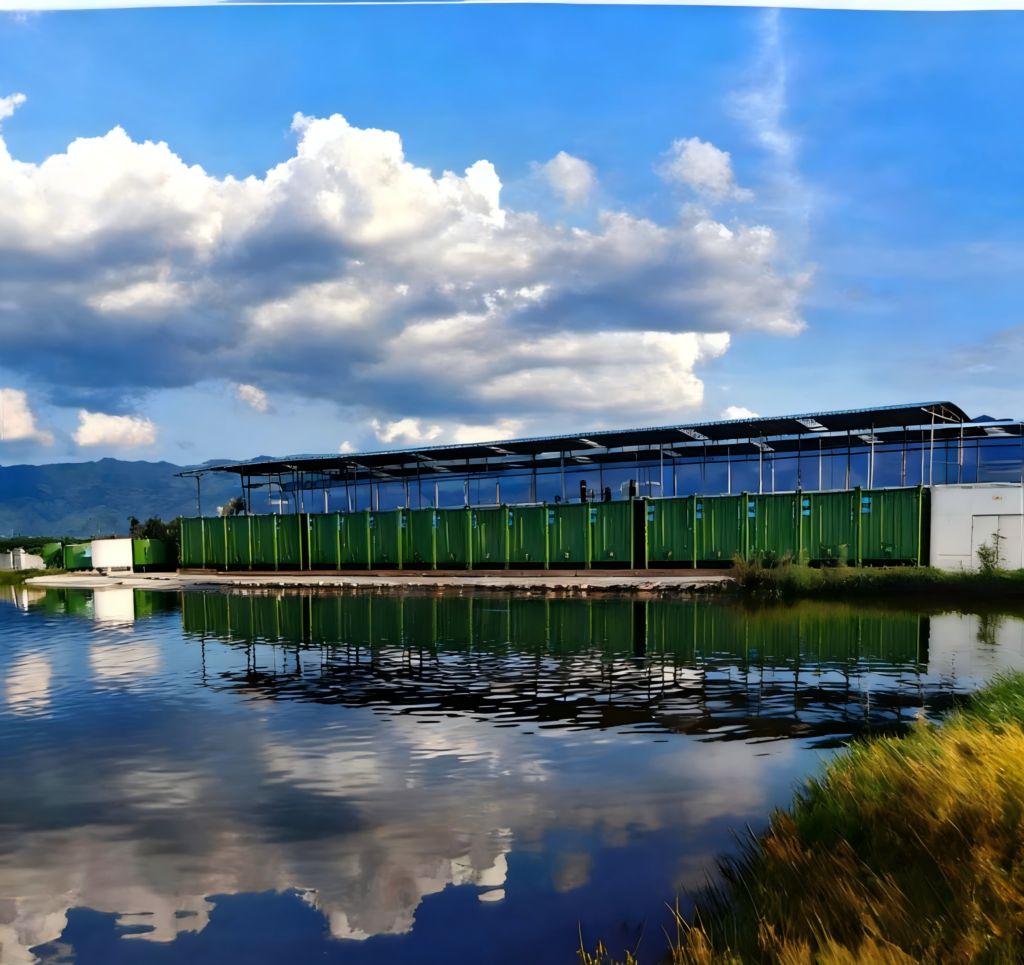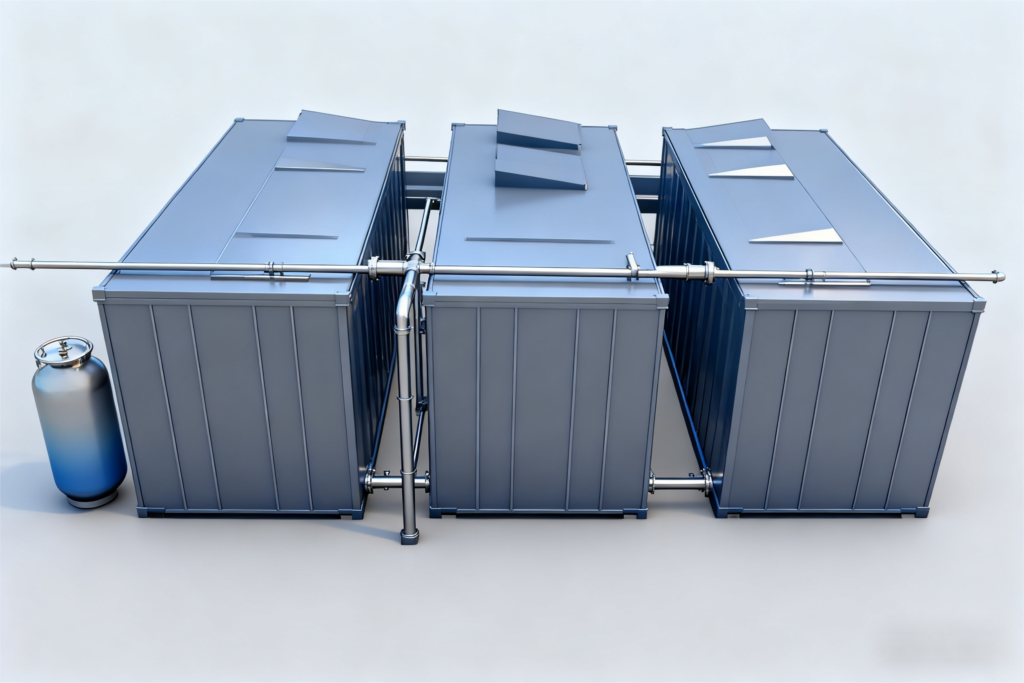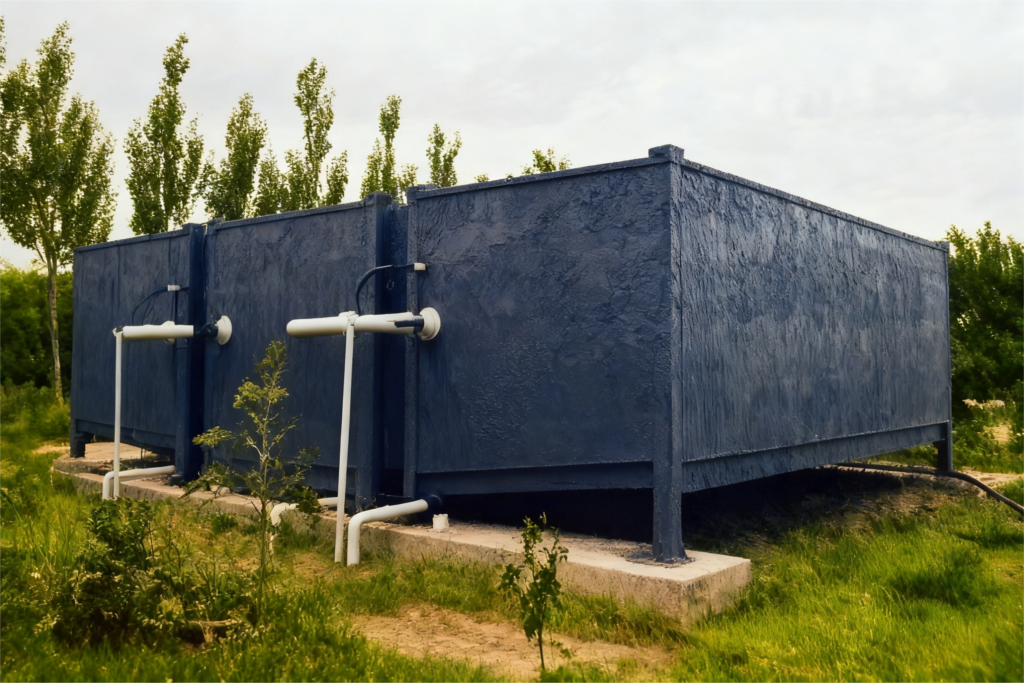What is land-based containerized aquaculture?

Containerized fish farming is an emerging model for standardized, modular, and industrialized recirculating aquaculture using containers. This model innovatively utilizes customized 20-foot standard containers (capable of accommodating 25 meters of aquaculture water) as a carrier. By integrating advanced technologies such as recirculating aquaculture, biological water purification, flow-through aquaculture, disease prevention and control, sewage collection and disposal, and IoT-enabled intelligent management, it effectively controls the aquaculture environment and processes, implementing controlled intensive aquaculture and achieving the goals of efficient resource utilization, water recycling, environmental protection, energy conservation, green production, and risk control. Depending on the scope of application and water treatment methods, this technology model can be categorized as land-based aquaculture and a “one-to-two” model.
(1) Land-based aquaculture
The land-based aquaculture model primarily utilizes large ponds as a buffer and water treatment system, transforming traditional aquaculture ponds into wetland-like ecological ponds. This represents an innovation in traditional pond aquaculture. Model Overview: A row of containers is placed along the pond bank, and fish raised in the pond are moved to the containers. The tank and pond form an integrated circulation system. Water drawn from the pond is sterilized with ozone and then used for continuous fish farming within the container. The aquaculture wastewater undergoes solid-liquid separation and is then returned to the pond for treatment. Feed and fish medicine are no longer added to the pond, and the pond’s primary function becomes a wetland ecological pond.

(2) “One-to-Two” Model
The “one-to-two” model consists of a water treatment tank and two aquaculture tanks. The intelligent water treatment tank is the core and key to this model. This model generally utilizes groundwater and implements a fully enclosed aquaculture system. The system integrates six technical modules: water quality measurement and control, feces collection, water purification, oxygen supply and constant temperature, aquaponics, and smart fisheries. Through the “six control” technologies of temperature, water, seedling, feed, bacteria, and algae control, it ensures full controllability and quality safety throughout the aquaculture process, achieving intelligent, standardized, green, ecological, resource-intensive, and refined industrialized aquaculture.

Six Unparalleled Advantages
Container fish farming has created a new model for modern aquaculture, establishing a new path to improve economic, ecological, and social benefits, and setting a new example for green development, transformation and upgrading, and industrial poverty alleviation in the fishery industry.
·Land and Water Conservation
In terms of land conservation, container fish farming occupies a small footprint, is flexible to install, and is highly mobile. This maximizes the use of non-arable land, minimizes damage caused by deep excavation, and effectively reduces the impact of infrastructure on land occupation, creating a new model for intensive land use. Land-based push-water ponds increase aquaculture efficiency by three times, saving 75% of pond space while maintaining the same output and value. A single “one-to-two” system occupies only 60 square meters, offering an average yield comparable to that of a 4-mu (approximately 1.5 acres) traditional pond, saving nearly 98% of pond space. In terms of water conservation, the land-based push-water production process constantly circulates water between the container and the pond, eliminating the issues of pond cleaning, desilting, and wastewater discharge common in traditional pond aquaculture, thus saving significant water resources. The “one-to-two” system is a completely closed system, with water recycled within the container. This allows for year-round water changes, requiring only minimal replenishment, resulting in significant water savings. Faced with the dual pressures of space constraints in traditional aquaculture and the massive water consumption of factory-based aquaculture, the advantages of container fish farming in terms of land and water conservation are becoming increasingly prominent.

· Controllable Quality
From the aquaculture concept to the system design, the container fish farming model is designed to ensure the health and safety of aquacultured species and the supply of high-quality aquatic products to the public. First, the controlled water quality and constant temperature of container fish farming minimize the incidence of disease, effectively reducing the use of medications. The finished fish are free of drug residues and heavy metal accumulation, meeting food safety standards with a 100% pass rate. Second, aeration and water-pushing aquaculture forces fish to move upstream as they grow, burning off excess fat. This not only maintains a beautiful body shape but also enhances meat elasticity, eliminates earthy odor, and improves quality, resulting in a significant market price advantage. Third, the tank bottom is designed with a 10° slope. During harvest, adult fish are concentrated to one side of the tank bottom, following the current. This reduces the time they spend out of water, reduces stress, and prevents skin damage, resulting in virtually harmless harvesting (a significant advantage over pond and factory farming). During transportation, unharmed adult fish are more resilient to the environment and less susceptible to water mold disease, thus avoiding the use of banned drugs such as malachite green during transportation, thus ensuring food quality and safety from box to table.
· Intelligent Standards
First, it integrates advanced technologies such as modern facilities and equipment, precise water quality control, biochemical wastewater treatment, and intelligent production management to create an intelligent, intensive, and modern aquaculture technology system. The aquaculture process utilizes automated management and refined control. Leveraging Internet of Things technology, this not only provides comprehensive early warning and real-time monitoring at the aquaculture base, but also connects to the R&D base for remote monitoring, remote configuration, and technical operation. This has gradually established a basic database for container fish farming models, significantly improving the efficiency and level of intelligent, scientific management. Secondly, standardized production capacity has been significantly enhanced. Scientific standards and technical operating procedures have been established for everything from fry stocking and feed selection to supporting aquaculture techniques. This ensures consistent and controllable technical procedures for fry marking, temporary cage rearing, and adult fish rearing. This model offers excellent stability and replicability, resulting in high-quality aquatic products with consistent specifications and commercial appeal. Compared to traditional pond aquaculture, it offers significant advantages in fry stocking, feed feeding, water quality control, harvest timing, and mature fish selling price. Thirdly, learning and training are convenient. The entire technology is user-friendly, highly controllable, simple to operate, and easy to manage. Users can master the essential techniques in just 7-10 days of training, ensuring the correct implementation of aquaculture techniques. This makes it suitable for rapid learning and application by grassroots aquaculture personnel.
·Green Ecology
Container fish farming prioritizes water resource recycling, transforming traditional aquaculture practices, fostering a resource-saving development model, and promoting green development in aquaculture. Integrating ecological agriculture and fish-vegetable symbiosis into the production process, the system centrally collects fish waste and excrement for use as organic fertilizer for vegetables, transforming waste into valuable resources, achieving clean production and zero pollution, and effectively improving the ecological environment. This has been demonstrated in container fish farming cases in 12 provinces. This model can replace traditional aquaculture in natural waters. While maintaining aquatic product production and supply without impacting fishermen’s livelihoods, it can gradually replace cage and net enclosure aquaculture, providing solutions for implementing measures such as returning fish to lakes, rivers, and seas, and creating beautiful bays.
·Changing Landscapes
From the perspective of fish farmers, container fish farming has established a new model for industrialized fish farming. Automated and intelligent farming methods have reduced labor intensity and increased efficiency, allowing fishermen to say goodbye to traditional farming methods and alleviate the arduous pond labor of yesteryear. In particular, the highly intensive and modernized “one-to-two” farming model has significantly improved the scientific and technological literacy of fish farmers, transforming ordinary fishermen into knowledgeable and skilled “industrial workers.” From the perspective of fishery development, container fish farming has broken with traditional mindset, transforming previously unthinkable and unattainable aquaculture models into an industrialized and modernized container fish farming model. Driven by innovation, it has driven a shift in aquaculture practices, significantly changing the traditional “dependence on the weather” model and becoming a key practice in promoting the transformation and upgrading of the fishery industry. From an industrial perspective, container fish farming integrates recreational fishing, fishing and harvesting, and specialty dining, creating a highly engaging, engaging, and entertaining experience. It allows people to experience the joys of fish farming while enjoying beautiful scenery and delicious food. This, in turn, expands the functions of the aquaculture industry and promotes the integration of the primary, secondary, and tertiary industries.
·Industrial Poverty Alleviation
With the continuous innovation of container fish farming models, its unique advantages in economic, ecological, and social benefits have become increasingly apparent. Many regions have gradually designated it as a key poverty alleviation project. It has already achieved initial success and has a promising future.


